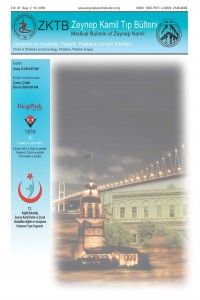Abstract
Introduction and aim: Hemangiomas are benign proliferative lesions of the blood vessels. The hemangiomas may be present in different locations such as skin, abdomen or intracranial. They may accompany syndromes as Kasabach-Meritt and Klippel-Trenaunay-Weber. The aim of this study is to emphasize the importance of early surgical intervention during the early postnatal period in order to prevent the late complications of giant hemangiomas.
Case report: A 26-days-old boy newborn was admitted to our clinic presented with a protruded mass with capillary proliferations on it, located in the right axilla, with dimensions of 10x10cm. Presumptive diagnosis was a hemangioma because of the vascular appearance of the mass. He had not thrombocytopenia, and any pathology was found in abdominal and intracranial ultrasonography (US). Echocardiography was revealed ASD, and PDA, and peripheral pulmonary stenosis. In magnetic resonance imaging (MRI) of the mass and thorax, a 12 cm diameter mass on posterolateral of the right hemi-thorax wall, filling the right axillary fossa, supplied by a thick branch from axillary artery, showing no invasion to the thoracic wall was observed. The mass was totally excised with open surgery. The postoperative period was uneventful and the patient was discharged on the fifth postoperative day. No recurrence was detected one year later on follow-up.
Conclusion: Hemangiomas may regress spontaneously within the first 3 years in the clinical follow-up. Since the giant cavernous hemangiomas may cause cardiac failure besides causing thrombocytopenia and blood loss due to their tendency to bleeding, surgical intervention in the early postnatal period following rapid completion of preoperative preparations is mandatory to prevent possible complications and to achieve good cosmetic results.
References
- Low DW. Hemangiomas and Vascular Malformations. Sem Ped Surg. 1994; 3 (2) : 40-61.
- Santecchia L, Francesca Bianciardi Valassina M, Maggiulli F, Spuntarelli G, De Vito R, Zama M. Early surgical excision of giant congenital hemangiomas of the scalp in newborns: clinical indications and reconstructive aspects. J Cutan Med Surg. 2013; 17(2):106-113.
- Spector JA, Blei F, Zide BM. Early surgical intervention for proliferating hemangiomas of the scalp: Indications and outcomes. Plast Reconstr Surg. 2008;122(2): 457-462.
- Wu JK, Rohde CH. Purse-string closure of hemangiomas: Early results of a follow-up study. Ann Plast Surg. 2009; 62(5): 581-585.
- Amir J, Metzker A, Krikler MB, Reisner SH. Strawberry Hemangioma In Preterm Infants. Pediatr Dermatol. 1986; 3: 331-332.
Abstract
Giriş ve Amaç: Hemanjiyomlar kan damarlarının iyi huylu proliferasyonlarıdır. Kafa içi, karın ve cilt gibi birçok lokalizasyonda olabildikleri gibi, Kasabach Meritt, Klippel Trenaunay Weber Sendromu gibi sendromlarla beraber de olabilirler. Dev hemanjiyomların postnatal erken dönemde opere edilerek olası geç komplikasyonların önüne geçilebileceğini vurgulanması amacıyla olgumuz sunulmuştur.
Olgu sunumu: 26 günlük erkek olgu sağ aksiller bölgede 10 x10 cm dışarıya doğru büyüyen kitle nedeniyle yatırıldı. Kitlenin üzerinde kılcal hemanjiyomların gözlenmesi nedeniyle hemanjiyom olduğu düşünüldü. Trombositopeni izlenmeyen hastada kranial ve batın ultrasonografisi (US) normal bulundu. Ekokardiografik incelemede ASD, ince PDA ve periferik pulmoner stenoz saptandı. Manyetik rezonans görüntüleme (MRG) incelemede; sağ aksiller arterden geniş bir pedikülle beslenen, sağ hemitoraks duvarı posterolaterali ve aksiller fossayı dolduran ve toraks duvarına invazyon izlenmeyen yaklaşık 12 cm boyutunda damarsal yapıdan zengin hemanjiyom olduğu düşünülen kitle izlendi. Ameliyat sırasında kitle pedikülünün 11 mm çapında çok geniş olduğu görüldü ve kitle total eksize edildi. Ameliyat sonrası beşinci gün sorunsuz olan taburcu edilen hastanın birinci yıl kontrolünde nüks saptanmadı.
Sonuç: Hemanjiyomlar ilk 3 yıl içinde kendiliğinden regrese olabileceği bilindiği için klinik olarak takip edilmektedir. Ancak dev kavernöz hemanjiyomlar, trombositopeni ve kanamaya eğilimleri yanısıra kardiak yetersizliğe neden olabilecekleri için bu olguların erken postnatal dönemde ameliyat öncesi hazırlıklarının tamamlanması ve takiben opere edilmesi; kozmetik iyi sonuç ve olası komplikasyonları önleme açısından gereklidir.
References
- Low DW. Hemangiomas and Vascular Malformations. Sem Ped Surg. 1994; 3 (2) : 40-61.
- Santecchia L, Francesca Bianciardi Valassina M, Maggiulli F, Spuntarelli G, De Vito R, Zama M. Early surgical excision of giant congenital hemangiomas of the scalp in newborns: clinical indications and reconstructive aspects. J Cutan Med Surg. 2013; 17(2):106-113.
- Spector JA, Blei F, Zide BM. Early surgical intervention for proliferating hemangiomas of the scalp: Indications and outcomes. Plast Reconstr Surg. 2008;122(2): 457-462.
- Wu JK, Rohde CH. Purse-string closure of hemangiomas: Early results of a follow-up study. Ann Plast Surg. 2009; 62(5): 581-585.
- Amir J, Metzker A, Krikler MB, Reisner SH. Strawberry Hemangioma In Preterm Infants. Pediatr Dermatol. 1986; 3: 331-332.
Details
| Primary Language | Turkish |
|---|---|
| Subjects | Health Care Administration |
| Journal Section | PEDIATRIC SURGERY |
| Authors | |
| Publication Date | May 8, 2016 |
| Published in Issue | Year 2016 Volume: 47 Issue: 2 |

